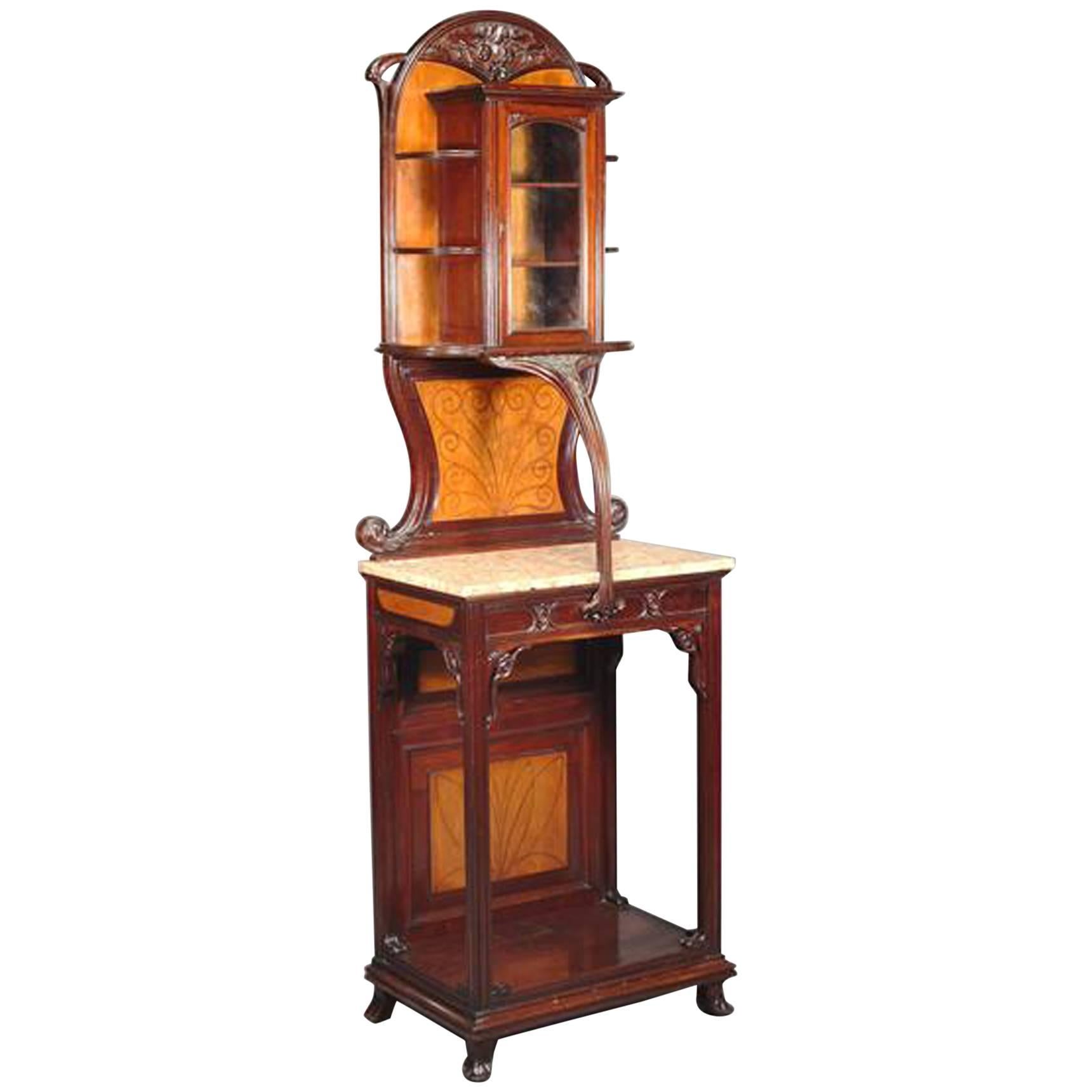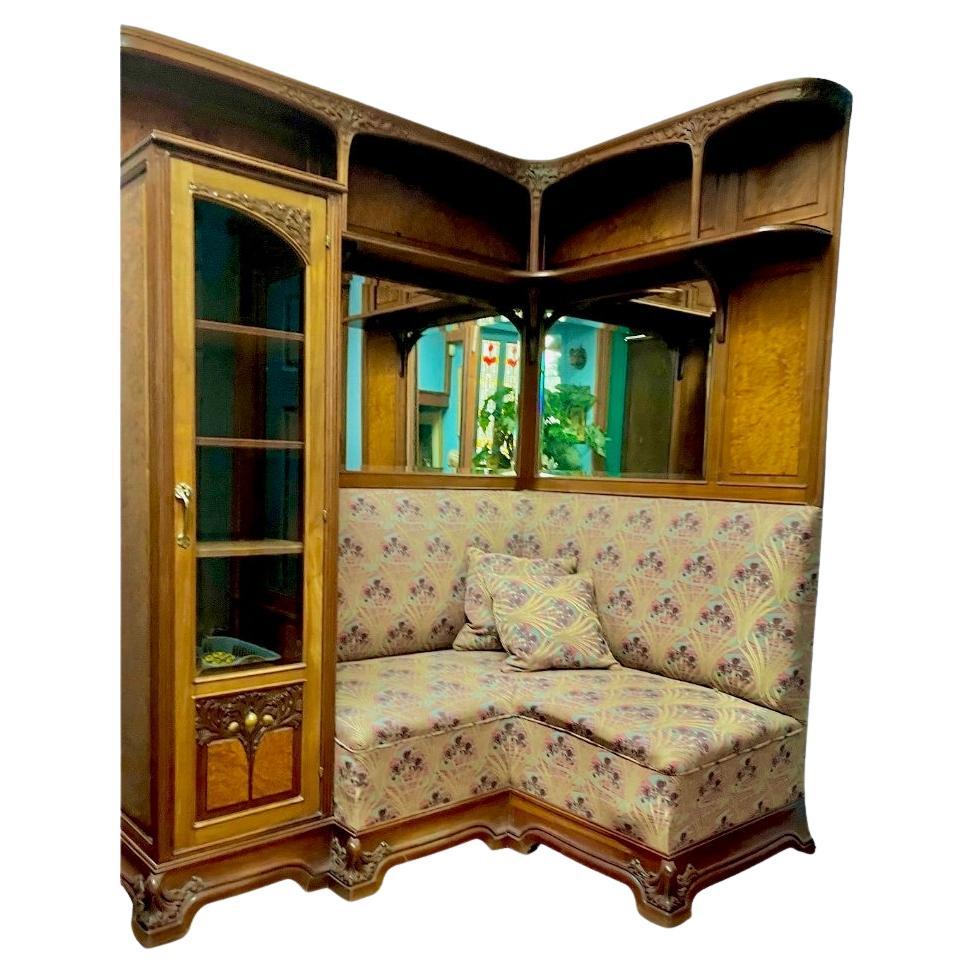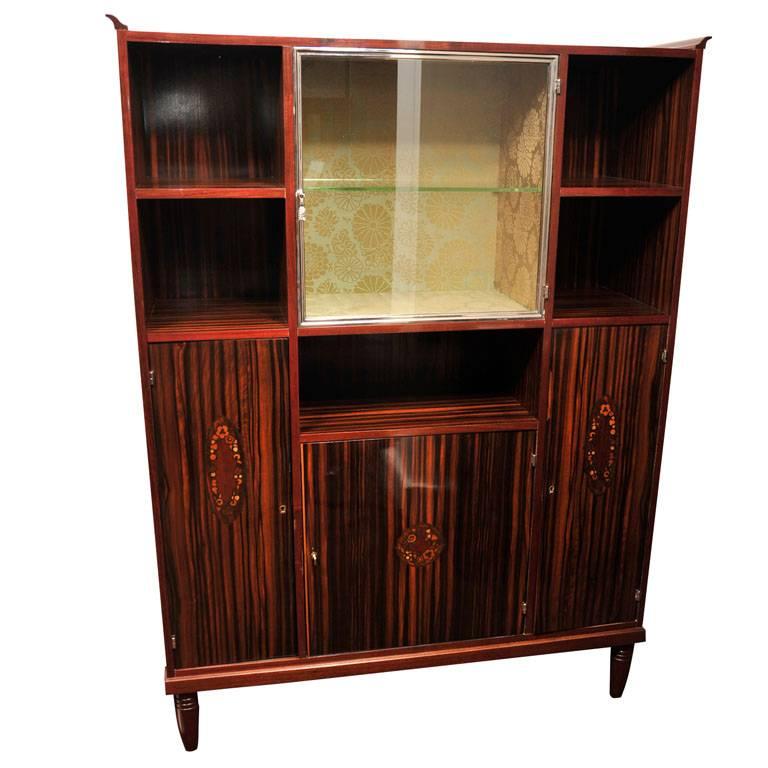Items Similar to Cloisonne Art Nouveau Cabinet, Louis Majorelle Attributed
Want more images or videos?
Request additional images or videos from the seller
1 of 14
Cloisonne Art Nouveau Cabinet, Louis Majorelle Attributed
About the Item
Edler Jugendstil Salonschrank mit floralen Schnitzereien und feiner Cloisonné-Glasarbeit, Louis Majorelle zugeschrieben, Nancy um 1900-1907.
Der Salonschrank besteht aus einem Rahmengestell aus Amerikanischen Kirschbaum, in dessen Zentrum ein exklusives Notenschränkchen mit einem Türchen befestigt ist. Die Türfüllung von dem Schränkchen zeigt ein Glasperlenbild mit einer Dame des Jugendstils, die die Muse der Musik darstellt. Bei dem Glasperlenbild handelt es sich um ein seltenes Cloisonné Glas. Die Cloisonné-Technik ist eine sehr feine Glasarbeit, bei der durch Glasperlen und gemahlenes Glasgranulat, Figuren, Ornamente oder andere Motive dargestellt werden können. Es sind nur noch wenige Exemplare auf dem internationalen Kunstmarkt zu finden. Stilistisch und thematisch erinnert das Objekt an die Entwürfe von Alfons Maria Mucha. Die Mucha-Foundation teilte auf Anfrage mit, dass diese Arbeit eindeutig von Alfons Mucha beeinflusst wurde, es sich aber nicht um eine Arbeit von Ihm handelt.
Das gesamte Möbel zeigt eine äußerst qualitätsvolle und aufwendige Verarbeitung. Dieser bedeutende Jugendstil Salonschrank befindet sich in einem exzellenten Zustand. In unserer Restaurierungswerkstatt wurde lediglich die Oberfläche gereinigt.
Der trapezförmige Grundriss des Möbels verjüngt sich sowohl von den Seiten als auch von der Front zur Rückwand hin. Vier allseitig profilierte Streben bilden das Gestell von diesem Korpus. Die beiden hinteren Streben sind mit der Rückwand verbunden. Alle vier Streben sind gekehlt und mit 3/4 Stäben profiliert. Das untere Querfries ist konkav eingezogen und dessen Unterkante geschweift ausgearbeitet. Die Zwickel sind mit Blumen im Halbrelief beschnitzt. Im oberen Bereich sind die Blumen durchbrochen beschnitzt und teilweise über die Profilierungen gelegt. Dieses sehr aufwendige und feine Verarbeitungsweise ist typisch für Louis Majorelle.
Der hochrechteckige Kasten ist an den Oberkanten gerundet und zeigt an den Seiten jeweils zwei Füllungen. Diese Füllungen werden von profilierten Zierleisten gerahmt. Die aufschlagende Tür zeigt einen gekehlten Rahmen und ist an die Form von dem Korpus angepasst. Die Lappenbänder aus Messing sind verkröpft, wodurch sich die Türe um fast 180° öffnen lässt. Innen ist das Notenschränkchen allseitig mit rötlich poliertem Vogelaugenahorn furniert. Die zwei Einlegeböden sind original zugehörig und lassen sich über Zahnleisten in der Höhe verstellen. Die Flächen sind ebenfalls beidseitig mit Vogelaugenahorn furniert. Die Füllungen im Korpus und an der Tür innen werden durch ebonisierte Viertelstäbe gerahmt. Der obere Abschluss des Schränkchens bildet ein Postament für ein dekoratives Objekt, wie eine schöne Jugendstil Tischlampe oder eine Skulptur.
Im Jahre 1897 meldete die in London ansässige Firma "Cloisonné Glass Company" das Patent "Improvements in Cloisonné Work" an. Bei diesem Patent handelt es sich um eine Unterart der häufig vorkommenden Cloisonne-Arbeiten, bei denen sich das Glasgranulat durch einen Schmelzprozess miteinander verbindet. Die Cloisonné Glass Company entwickelte ein Verfahren, bei dem zwischen zwei Glascheiben, die Konturen der Darstellung durch Messingstege gebildet werden. Die Zwischenräume bilden die Flächen, welche mit farbigen Glasperlen und feinem, farblich unterschiedlich schattiertem Glasgranulat aufgefüllt werden.
In verschiedenen Büchern werden Anwendungsbereiche für Cloisonné-Glasbilder dieser Art erwähnt. So wurden diese beleuchtet oder opak für Fenster, Laternen, Deckenleuchten, Jalousien, Möbel, Reklametafeln oder Dekoration in Häusern und öffentlichen Gebäuden verwendet. Mittlerweile sind leider nur noch wenige derartige Glasobjekte erhalten.
Dieser äußerst gute Erhaltungszustand des Cloisonné Bilds ist sehr ungewöhnlich. Im Allgemeinen sind die wenigen erhaltenen Arbeiten sehr restaurierungsbedürftig.
Dieses qualitätsvolle und äußerst seltene Jugendstilmöbel befindet sich in einem musealen Zustand. Es ist voll benutzbar und wurde von uns lediglich gereinigt. Das Glasperlenbild ist in einem unbeschädigten Originalzustand. Selbst die beiden Einlegeböden im Innenraum, wie auch die Beschläge, das Schloss und der Schlüssel, sind original zugehörig. Wir freuen uns, Ihnen dieses ausgesprochen qualitätsvolle Möbel anbieten zu können.
- Attributed to:Louis Majorelle (Designer)
- Dimensions:Height: 74.61 in (189.5 cm)Width: 36.23 in (92 cm)Depth: 17.72 in (45 cm)
- Style:Art Nouveau (Of the Period)
- Materials and Techniques:
- Place of Origin:
- Period:1900-1909
- Date of Manufacture:1900-1907
- Condition:
- Seller Location:Heiligenberg, DE
- Reference Number:1stDibs: LU7944233625402
About the Seller
No Reviews Yet
Vetted Seller
These experienced sellers undergo a comprehensive evaluation by our team of in-house experts.
1stDibs seller since 2023
- ShippingRetrieving quote...Ships From: Heiligenberg, Germany
- Return PolicyA return for this item may be initiated within 14 days of delivery.
More From This SellerView All
- Commode After Benneman and Stöckel, Louis XVI Paris Around 1900By Benneman and StockelLocated in Heiligenberg, DELouis Seize style state chest of drawers, solid mahogany and veneered, with rich brass fittings (signed E. KAHN) and marble top, Paris circa 1900. This chest of drawers is a very large presentation furniture with a width of almost 1.80 meters. It is an authentic collector's item. This dresser is in full working restored condition. This wide dresser stands on tall turned legs and features rounded corner studs with fluting. The front is designed with two doors and three drawers above. The dresser top, made of 2.7 cm thick Cararra marble, protrudes and matches the body shape at the outer edges. Behind the two doors are 6 drawers that can be pulled out on drop rings. All three visible sides are lush with hardware and feature large medallions in the center. All three medallions are framed by a round egg bar ornamental molding. The corner studs show fluting inlaid with brass. All locks are stamped "Paris". Some of the bronzes have the casting stamps "E. Kahn" on the back. The body of the chest of drawers can be disassembled by threaded screws was designed so that the body can be completely disassembled. The chest of drawers is delivered assembled. The dresser has been gently restored preserving the patina and slight signs of use, is fully functional and equipped with four keys. Photos of the unrestored condition are available. The Paris based company "E. Kahn & Cie" specialized in high quality reproduction of 18th century furniture. They copied furniture from the French ebenists such as Riesener, Oeben, Weisweiler, Stöckl, Cressent and Benneman, which were reproduced 1:1 or partly slightly modified, with high quality. The model for this chest of drawers was a pair of royal chests of drawers designed by J. STÖCKL (Joseph Stöckel, master 1775) and completed by G. BENNEMAN (Guillaume Bennemann, master 1785). In 1786 the pair of chests of drawers was delivered to Marie Antoinette's gambling salon (Salon des Jeux) at Fontainebleau castle. Currently it is in the collection of the Louvre in Paris (Commode 1, Commode 2). The commode type in the form of a sideboard with additional drawers behind the doors is also called commode à vantaux. Especially this commode is also called Marie Antoinette commode.Category
Antique 1890s French Louis XVI Commodes and Chests of Drawers
MaterialsHardwood
- Jugendstil KonzertstuhlBy Hector GuimardLocated in Heiligenberg, DEKonzerststuhl aus dem Jugendstil, Frankreich um 1900. Die formschönen Wangen aus Gusseisen sind Hector Guimard (1867 Lyon - 1942 New York City) zugeschrieben. Hector Guimard war eine...Category
Antique Early 1900s French Art Nouveau Armchairs
MaterialsIron
- German Baroque Secretary with Mirror and Silver Plated Fittings from 1730/35Located in Heiligenberg, DETwo-piece baroque secretary with mirrored doors, exceptional original silvered fittings with numerous princely crowns, walnut saw veneer on softwood, Thuringia circa 1730/35. This secretary comes from princely property, was made in very high craftsmanship and is in an impeccably restored condition. In addition to the mirrored glass, the elaborate front of the top is adorned with three pilasters, the shaft of which is framed by double fillet bands and features a walnut field in the center. The profiled bases are cast in silver-plated brass. The three capitals are elaborate silvered castings with leaves and volutes. Under the doors, two delicate shelves with walnut fronts can be pulled out on fine silver-plated knobs. The knobs are the same model as the small drawers in the single-door. Pulling out the shelves reveals a framed area of oak. The framing is multi-profiled, very finely worked and mitered. The trays were probably intended for candlesticks. The light from the candles is clearly enhanced by the mirrors. At that time, this effect was also used for wall blinds. The carcass sides of the entire piece of furniture are identical in design. The base shows mirrored fields with a cross-veneered framing. In the case of the top, the field is mirrored four times in the form of a cross joint and is also bordered by a cross-veneered framing. On both sides of the base and the top are strong, silver-plated handles, with a splendidly designed base plate of chased, silver-plated brass sheet. Here again we encounter the princely crown. On the original back panel is a handwritten note in chalk: "Salon der Durchl. Fürstin von der Lippe...Category
Antique 1730s German Baroque Secretaires
MaterialsWalnut
- French Bureau Plat Around 1900Located in Heiligenberg, DESplendid Bureau Plat veneered with rosewood and decorated with bronze applications, France 19th century. Bureau Plat is in restored condition with shellac polished surface. This ...Category
Antique 1890s French Louis XVI Secretaires
MaterialsKingwood
- German Biedermeier Chest of Drawers with Top and Columns from 1820Located in Heiligenberg, DEBiedermeier top chest of drawers made of walnut with four doors, ebonized half columns with black lot painting, probably Munich around 1820. This top chest of drawers is in restored ...Category
Antique 1820s German Biedermeier Commodes and Chests of Drawers
MaterialsWalnut
- Österreich/Wien 4 Stühle Mit Leder Gustav Gassmann Um 1880Located in Heiligenberg, DEEs handelt sich um einen seltenen Satz Gründerzeit Stühle in einem sehr guten Erhaltungszustand mit schöner Patinaoberfläche und sehr dickem Leder. Die Stühle wurden von der Firma Gu...Category
Antique 1880s Austrian Renaissance Revival Chairs
MaterialsLeather, Walnut
You May Also Like
- Art Nouveau Carved Walnut inlaid & glazed Salon Cabinet by Louis MajorelleBy Louis MajorelleLocated in London, GBLouis Majorelle (1859-1926), an Art Nouveau carved walnut, inlaid and glazed salon cabinet, with stylised floral carved details to the crown with a centr...Category
Early 20th Century French Art Nouveau Cabinets
MaterialsWalnut
- Majorelle Art Nouveau VitrineBy Louis MajorelleLocated in Saverne, Grand EstVitrine signed "L.Majorelle" in walnut and veneer, molded and carved with clematis decoration. The central box opens on the front with a partly glazed door presenting a lower inlaid ...Category
Antique Early 1900s French Art Nouveau Vitrines
MaterialsWalnut
- Louis Majorelle Signed Corner Bibliothéque de Présentation art Nouveau NancyBy Louis Majorelle, Ecole de NancyLocated in Verviers, BEMajorelle Art Nouveau Presentation Bookcase reading corner Superb collector's bookcase in solid molded walnut, finely carved and panelled. Asymmetrical frame opening with solid door at the Left, a glass door and 4 open niches at the top. Locks and drawer handles in gilded bronze. Very fine original condition. Superb quality commissioned model Art Nouveau William morris upholstery fabric.Category
Vintage 1920s French Art Nouveau Vitrines
MaterialsBronze
- 20th Century French Art Nouveau "Fleurs d'Aubépine" Vitrine by, Louis MajorelleBy Louis MajorelleLocated in Englewood, NJAn early 20th century fine and rare French Art Nouveau carved and inlaid Marquetry "Fleurs d'Aubépine" (Hawthorne flowers) walnut single door display cabinet by, French Master Furnit...Category
Early 20th Century French Art Nouveau Vitrines
MaterialsBronze
- French Art Deco Vitrine by Louis MajorelleBy Louis MajorelleLocated in Pompano Beach, FLFrench Art Deco vitrine by Louis Majorelle made of Macassar ebony. Center glass door with floral fabric lined interior. Three doors with exterior floral marquetry and interior shelve...Category
Vintage 1930s French Vitrines
- Louis Majorelle Gilt Walnut "Aux Pins" VitrineBy Louis MajorelleLocated in New York, NYThis gilt vitrine "aux pins" by Louis Majorelle is a masterpiece in Art Nouveau design. The gilt finish and simplicity of line that unifies the piece lend it a refined elegance, making it the perfect frame for carefully selected objets d’art. Louis Majorelle’s father Auguste had specialized in 18th-century style furniture, including the chinoiserie so loved in the court of Louis XVI. Louis Majorelle experimented with the pine motif at the same time as Rene Lalique. Both looked to East Asian Art...Category
Early 20th Century French Art Nouveau Vitrines
MaterialsGlass, Giltwood, Fabric
Recently Viewed
View AllMore Ways To Browse
Antique Den
Antique Fur
Art Nouveau Nancy
Art Nouveau Nancy Furniture
Art Nouveau Majorelle
Art Nouveau Cabinet Carved
Antique Glas
Antique Messer
Curved Glass Vitrine
Vitrine And China Cabinets
Louis Xvi Style Vitrine
Xvi Style Vitrine
Curved Glass Vitrine Cabinet
Deco Display Vitrine
Louis Xvi Style Vitrine Cabinet
Art Deco Display Vitrine
Antique French Display Vitrine
Vitrine Used Look





